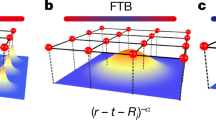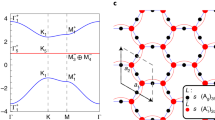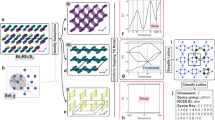Abstract
The promise of photonic crystals and their potential applications1,2 has attracted considerable attention towards the establishment of periodic dielectric structures that in addition to possessing robust complete bandgaps, can be easily fabricated with current techniques. A number of theoretical structures have been proposed3,4,5,6,7,8,9,10,11,12,13,14,15. To date, the best complete photonic bandgap structure is that of diamond networks having Fd3m symmetry (2-3 gap). The only other known complete bandgap in a face-centred-cubic (f.c.c.) lattice structure is that of air spheres in a dielectric matrix (8-9 gap; the so called 'inverse-opal' structure). Importantly, there is no systematic approach to discovering champion photonic crystal structures. Here we propose a level-set approach based on crystallography to systematically examine for photonic bandgap structures and illustrate this approach by applying it to the 11 f.c.c. groups. This approach gives us an insight into the effects of symmetry and connectivity. We classify the F-space groups into four fundamental geometries on the basis of the connectivity of high-symmetry Wyckoff sites. Three of the fundamental geometries studied display complete bandgaps—including two: the F-RD structure with Fm3̄m symmetry and a group 216 structure with F4̄3m symmetry that have not been reported previously. By using this systematic approach we were able to open gaps between the 2-3, 5-6 and 8-9 bands in the f.c.c. systems.
This is a preview of subscription content, access via your institution
Access options
Subscribe to this journal
Receive 12 print issues and online access
$259.00 per year
only $21.58 per issue
Buy this article
- Purchase on Springer Link
- Instant access to full article PDF
Prices may be subject to local taxes which are calculated during checkout


Similar content being viewed by others
Change history
16 September 2003
Changed authorname Craig W. Carter to W. Craig Carter
References
Soukoulis, C.M. Photonic Bandgap Materials (Plenum, New York, 1996).
Joannopoulos, J.D. et al. Photonic Crystals (Princeton Univ., Princeton, New Jersey, 1995).
Sozuer, H.S. et al. Photonic bands: Convergence problems with the plane-wave method. Phys. Rev. B 45, 13962–13972 (1992).
Ho, K.M. et al. Existence of a photonic gap in periodic dielectric structures. Phys. Rev. Lett. 65, 3152–3155 (1990).
Chan, C.T. et al. Photonic bandgaps in experimentally realizable periodic dielectric structures. Europhys. Lett. 16, 563–568 (1991).
Ho, K.M. et al. Photonic bandgaps in three dimensions: new layer-by-layer structures. Solid State Commun. 89, 413–416 (1994).
Yablonovitch, E. et al. Photonic band structure: the face-centered-cubic case employing nonspherical atoms. Phys. Rev. Lett. 67, 2295–2298 (1991).
Sozuer, H.S. & Haus, J.W. Photonic bands: simple-cubic lattice. J. Opt. Soc. Am. B 10, 296–302 (1993).
Biswas, R. et al. Three-dimensional photonic bandgaps in modified simple cubic lattices. Phys. Rev. B 65, 205121 (2002).
Toader, O. & John, S. Proposed square spiral microfabrication architecture for large three-dimensional photonic bandgap crystals. Science 292, 1133–1135 (2001).
Chan, C.T. et al. A7 structure: A family of photonic crystals. Phys. Rev. B 50, 1988–1991 (1994).
Fan, S. et al. Design of three-dimensional photonic crystals at submicron lengthscales. Appl. Phys. Lett. 65, 1466–1468 (1994).
Johnson, S.G. & Joannopoulos, J.D. Three-dimensionally periodic dielectric layered structure with omnidirectional photonic bandgap. Appl. Phys. Lett. 77, 3490–3492 (2000).
Maldovan, M. et al. Photonic properties of bicontinuous cubic microphases. Phys. Rev. B 65, 165123 (2002).
Campbell, M. et al. Fabrication of photonic crystals for the visible spectrum by holographic lithography. Nature 404, 53–55 (2000).
Wohlgemuth, M. et al. Triply periodic bicontinuous cubic microdomain morphologies by symmetries. Macromolecules 34, 6083–6089 (2001).
Ullal, C.K. et al. Triply periodic bicontinuous structures through interference lithography: a level-set approach. J. Opt. Soc. Am. A 20, 948–954 (2003).
Urbas, A.U. et al. Bicontinuous cubic block copolymer photonic crystals. Adv. Mater. 14, 1850–1853 (2002).
Acknowledgements
The authors would like to thank their respective financial sources: M.M. and W.C.C., The Singapore-MIT alliance. C.U. and E.L.T., US Air Force DURINT in conjunction with the University of Buffalo. E.L.T., the US Army through the Institute for Soldier Nanotechnologies, under contract DAAD-19-2002 with the Army Research Office.
Author information
Authors and Affiliations
Corresponding author
Ethics declarations
Competing interests
The authors declare no competing financial interests.
Rights and permissions
About this article
Cite this article
Maldovan, M., Ullal, C., Carter, W. et al. Exploring for 3D photonic bandgap structures in the 11 f.c.c. space groups. Nature Mater 2, 664–667 (2003). https://doi.org/10.1038/nmat979
Received:
Accepted:
Published:
Issue Date:
DOI: https://doi.org/10.1038/nmat979
This article is cited by
-
Assembled crystal structures of cubic patchy colloid-droplet mixtures: theoretical prediction and simulation study
Colloid and Polymer Science (2023)
-
Two-dimensional binary colloidal crystals formed by particles with two different sizes
Scientific Reports (2022)
-
The diversity of three-dimensional photonic crystals
Nature Communications (2021)
-
Reversible solid-state phase transitions in confined two-layer colloidal crystals
Colloid and Polymer Science (2020)
-
Structural colour of unary and binary colloidal crystals probed by scanning transmission X-ray microscopy and optical microscopy
Scientific Reports (2017)



